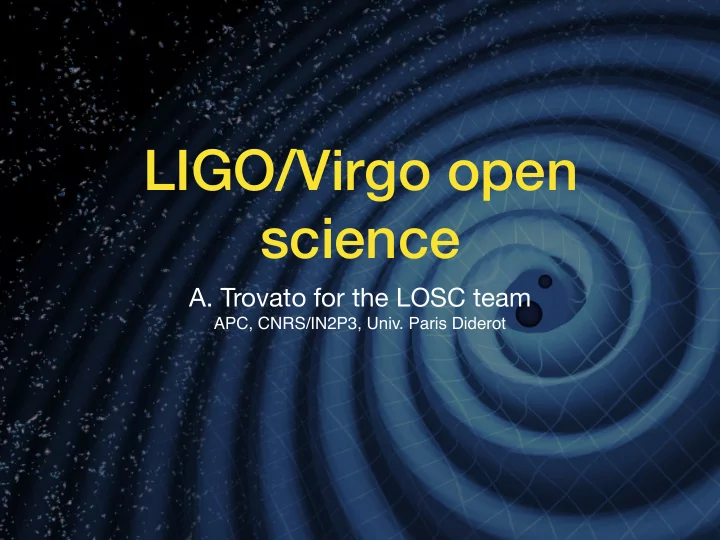

LIGO/Virgo open science A. Trovato for the LOSC team APC, CNRS/IN2P3, Univ. Paris Diderot
LIGO/Virgo data Main information in the Ligo/Virgo data: strain Reminder: gravitational wave strain h(t) —> time series Ligo/Virgo data are arranged in files provided in di ff erent formats: Hdf5: easily readable in python, MATLAB, C/C++, and IDL Frame format (.gwf) h = ∆ d = change in relative position Text file d separation A. Trovato - ASTERICS/DADI, 27th Jun 2018 � 2
LIGO/Virgo data Main information in the Ligo/Virgo data: strain Reminder: gravitational wave strain h(t) —> time series Ligo/Virgo data are arranged in files provided in di ff erent formats: Hdf5: easily readable in python, MATLAB, C/C++, and IDL Frame format (.gwf) h = ∆ d = change in relative position Text file d separation Meta-data for the file. This is basic information such as the GPS times You can use covered, which instrument, etc. HDFView to quickly Refers to data quality. The main see what is inside item here is a 1 Hz time series the file describing the data quality for each second of data. Strain data from the interferometer. In some sense, this is "the data", the main measurement performed by LIGO/Virgo. A. Trovato - ASTERICS/DADI, 27th Jun 2018 � 3
Available data sets Data available at www.gw-openscience.org or www.losc.ligo.org Two di ff erent types of data release: Gravitational wave data surrounding Data taken during a whole discoveries observation run Events available at the moment: Runs available at the moment (LIGO only): Name Detector Type Run • S5 (Nov 2005 - Oct 2007) GW150914 LIGO BBH O1 • S6 (Jul 2009 - Oct 2010) LVT151012 LIGO Candidate BBH O1 • O1 (Sep 2015 - Jan 2016) GW151226 LIGO BBH O1 GW170104 LIGO BBH O2 GW170608 LIGO BBH O2 GW170814 LIGO + VIRGO BBH O2 BBH = Binary Black Hole GW170817 LIGO + VIRGO BNS O2 BNS = Binary Neutron Star A. Trovato - ASTERICS/DADI, 27th Jun 2018 � 4
Runs timeline A. Trovato - ASTERICS/DADI, 27th Jun 2018 � 5
Where to find the data www.gw-openscience.org/data or www.losc.ligo.org/data These pages contain the data but provide also the information and the tools necessary to understand and use the data A. Trovato - ASTERICS/DADI, 27th Jun 2018 � 6
Tutorials www.losc.ligo.org/tutorials First Open Data Workshop (March 25 - 27, 2018, Caltech, Pasadena, CA): ✦ Lectures and hands-on introduction to working with software tools developed by the LIGO Scientific Collaboration and Virgo collaboration to access and process publicly available gravitational wave data. ✦ Project of a similar workshop in Europe (2019, after O3) Tutorials about the basics of data analysis applied to the realised BBH events A. Trovato - ASTERICS/DADI, 27th Jun 2018 � 7
Tutorials www.losc.ligo.org/tutorials More specific tutorials on the data structure and how to read them A. Trovato - ASTERICS/DADI, 27th Jun 2018 � 8
New releases planned: O2 Starting with O2 the delay for public data release will shrink to 18 months (from 24 months) —> 01/09/2017 + 18 m = 01/02/2019 BBH O2 Catalog paper under preparation Web version of the catalog stored on the LOSC page Still to be decided: Which events? Same as the paper? Which parameters for each event? Main ideas: structure of the data should be a table easy to maintain; the website should include tools for reading, plotting, interpreting the data GPS (UTC) M (final m1, Sky Luminosity Name Spin FAR SNR … m2, chirp) localisation distance … … … … … … … … GWxxxxxx GWyyyyyy … … … … … … … … A. Trovato - ASTERICS/DADI, 27th Jun 2018 � 9
Planned detectors sensitivity evolution arXiv:1304.0670v4 Multiplying the given range for the rate density for a source category, the corresponding detection rate can be calculated: in O3 O(1) BBH events per week expected Public alerts using GCN Notices and Circulars BNS = 1.4 M ⊙ + 1.4 M ⊙ BBH = 30 M ⊙ + 30 M ⊙ A. Trovato - ASTERICS/DADI, 27th Jun 2018 � 10
BBH Catalogue in Vizier BBH catalogue should go also in Vizier! GW events have di ff erent features than the typical events stored in Vizier! POSITION: Can we build catalog in Vizier when sky position is poorly known? Can we use a probability sky map to define the event position? E.g. store for each event some central position with some large errors to indicate the event extension on the sky map? If yes, can this catalog be queried? For instance, give me all BBH whose sky map overlap with direction RA, 𝛆 ? Possibility: fits file could be produced from the MOC created by Giuseppe Greco. In the future, MOC directly as VizieR entry? Can this catalog be crossmatched in position with other catalogs in Vizier? Galaxies, variable stars, etc WAVEFORMS: Can the waveforms (and eventually the templates) be stored? YES->timeseries PARAMETERS: Can parameters like the SNR/False alarm rate/BH masses/BH spins be stored? YES If yes, is it possible to search for all events with some values or (range of values) for these parameters? ADDITIONAL INFO: is it possible to add for each event a link to the main papers that discuss it? YES A. Trovato - ASTERICS/DADI, 27th Jun 2018 � 11
Thank you for you attention!
Recommend
More recommend